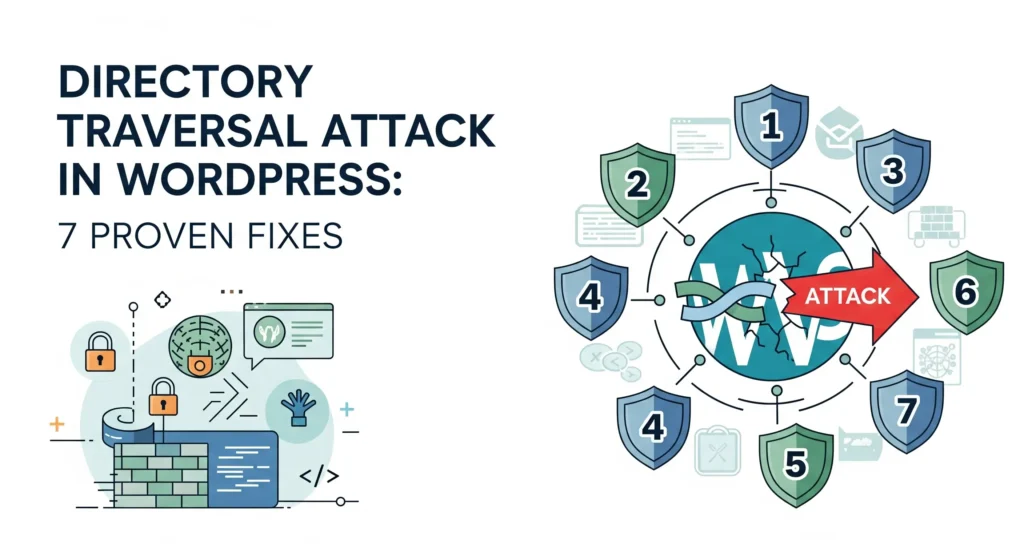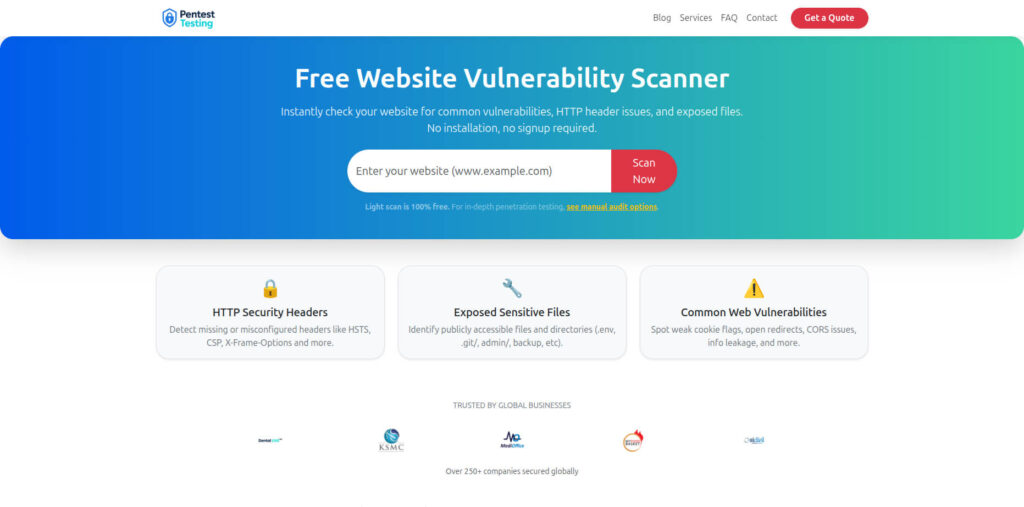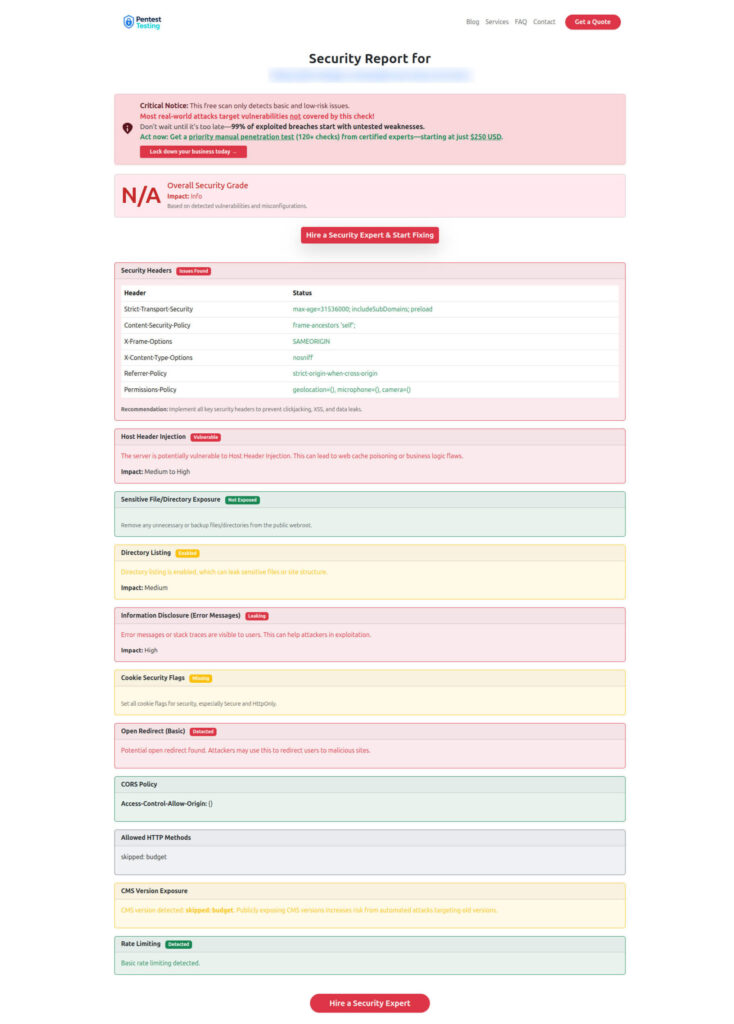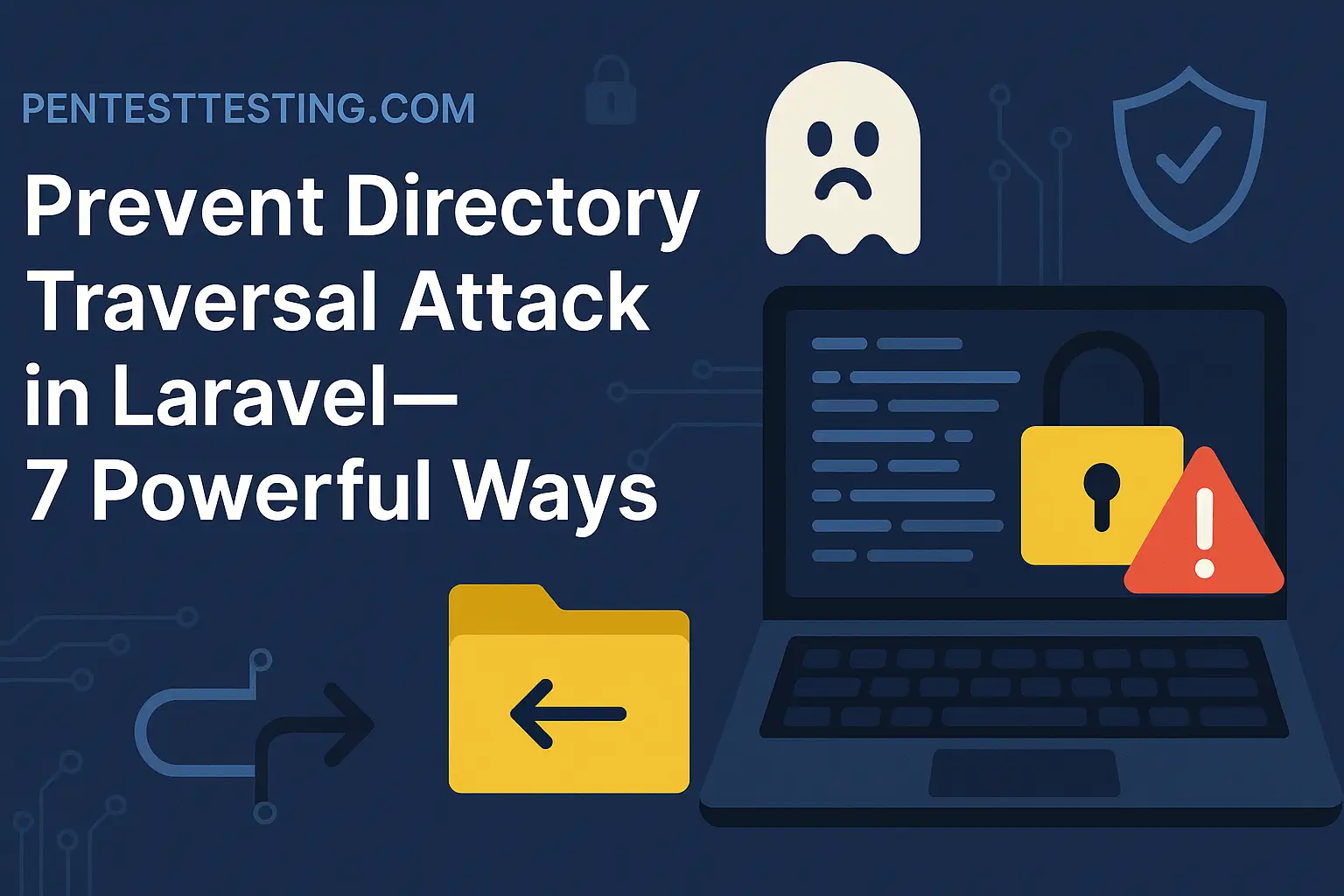Directory Traversal Attack in WordPress: 7 Proven Steps to Detect, Exploit, and Fix
Directory Traversal Attack in WordPress is a classic yet devastating issue where an attacker manipulates file paths (e.g., ../../wp-config.php) to read arbitrary files. In real sites, this can lead to credential leaks, plugin configuration exposure, or even code execution chains. In this deep-dive, you’ll learn how Directory Traversal Attack in WordPress typically happens, how attackers exploit weak endpoints, and the exact secure coding patterns and server hardening you can apply today.

We’ll mix practical PHP/WordPress code, server config snippets, and quick checks you can run. You’ll also find relevant resources across our security guides—like XSS Prevention in Node.js, XXE in WordPress, and SQL Injection Attack Mitigation in WordPress—because vulnerabilities rarely occur in isolation.
Who is this for? WordPress developers, plugin authors, theme vendors, and site owners who want actionable fixes against path traversal (aka “directory traversal” or “dot-dot-slash”).
1) What is a Directory Traversal Attack in WordPress?
A Directory Traversal Attack in WordPress occurs when untrusted input is concatenated into a filesystem path and the app fails to normalize/validate it. Attackers supply sequences like ../ to escape the intended directory (e.g., uploads) and read sensitive files such as wp-config.php, .env, or backup archives. Because WordPress and many plugins handle images, logs, and exports, unsafe file endpoints are common if not carefully implemented.
Red flags
- Query params like
?file=,?path=,?template=without allowlists. - Download/export features that accept full paths or raw filenames.
- AJAX handlers serving files without capability checks or nonces.
- Calls to
file_get_contents,fopen,readfile, orincludewith user input.
2) How it’s Exploited (With Repro Steps)
A deliberately vulnerable endpoint
// BAD: vulnerable-file-download.php
if (isset($_GET['file'])) {
$file = $_GET['file']; // e.g., "report.pdf" or "../../wp-config.php"
$base = __DIR__ . '/downloads/';
$target = $base . $file;
if (file_exists($target)) {
header('Content-Type: application/octet-stream');
header('Content-Disposition: attachment; filename="'.basename($target).'"');
readfile($target);
exit;
}
}Sample attack
curl -i "https://example.com/vulnerable-file-download.php?file=../../wp-config.php"If traversal isn’t blocked, the response may return the contents of wp-config.php.
3) Vulnerable Patterns in Themes & Plugins
a) Raw path joins
$path = $_GET['path']; // BAD
echo file_get_contents(WP_CONTENT_DIR . '/' . $path);b) Template or partial includes
include get_theme_file_path($_GET['template']); // BADc) Export/download helpers
$filename = $_GET['name']; // BAD
$full = plugin_dir_path(__FILE__) . 'exports/' . $filename;
readfile($full);d) Unchecked AJAX
add_action('wp_ajax_my_export', function () {
$file = $_POST['file']; // BAD
readfile($file);
wp_die();
});4) 7 Proven Steps to Prevent Directory Traversal
1) Canonicalize with realpath() and compare to a base
function safe_path_join($baseDir, $userInput) {
$base = rtrim($baseDir, DIRECTORY_SEPARATOR) . DIRECTORY_SEPARATOR;
$candidate = $base . ltrim($userInput, DIRECTORY_SEPARATOR);
$real = realpath($candidate);
if ($real === false) return false;
// Ensure the resolved path is inside $base
return str_starts_with($real, $base) ? $real : false;
}
// Usage:
$baseDir = plugin_dir_path(__FILE__) . 'downloads/';
if (isset($_GET['file'])) {
$safe = safe_path_join($baseDir, $_GET['file']);
if ($safe !== false && is_file($safe)) {
header('Content-Type: application/octet-stream');
header('Content-Disposition: attachment; filename="'.basename($safe).'"');
readfile($safe);
exit;
} else {
status_header(404);
echo 'Not found';
}
}2) Use allowlists (extensions + filenames)
$allowed = ['pdf','csv','txt'];
$ext = strtolower(pathinfo($_GET['file'] ?? '', PATHINFO_EXTENSION));
if (!in_array($ext, $allowed, true)) {
wp_die('Invalid file type.');
}3) Don’t trust user-supplied directories—fix the base
Keep files under a controlled folder (wp-content/uploads/my-plugin/) and never let the client pick parent directories.
4) Sanitize inputs with WP helpers
$filename = sanitize_file_name($_GET['file'] ?? '');
$filename = wp_basename($filename); // Strip directories5) For includes/templates, map keys, not paths
$views = [
'report' => 'views/report.php',
'table' => 'views/table.php'
];
$key = sanitize_key($_GET['view'] ?? '');
if (!isset($views[$key])) wp_die('Invalid view');
include plugin_dir_path(__FILE__) . $views[$key];6) Enforce capabilities & nonces in AJAX/file endpoints
add_action('wp_ajax_secure_download', function () {
check_ajax_referer('secure_download_nonce');
if (!current_user_can('manage_options')) wp_send_json_error('No permission');
$filename = sanitize_file_name($_POST['file'] ?? '');
$base = plugin_dir_path(__FILE__) . 'exports/';
$safe = safe_path_join($base, $filename);
if ($safe && is_readable($safe)) {
header('Content-Type: application/octet-stream');
header('Content-Disposition: attachment; filename="'.basename($safe).'"');
readfile($safe);
wp_die();
}
wp_send_json_error('Not found');
});7) Prefer the WordPress Filesystem API when writing
global $wp_filesystem;
if ( ! function_exists('WP_Filesystem') ) require_once ABSPATH . 'wp-admin/includes/file.php';
WP_Filesystem();
$upload_dir = wp_upload_dir();
$dir = trailingslashit($upload_dir['basedir']) . 'my-plugin/';
$wp_filesystem->mkdir($dir);
$wp_filesystem->put_contents($dir . 'log.txt', "ok\n", FS_CHMOD_FILE);These seven steps drastically reduce the risk of a Directory Traversal Attack in WordPress while keeping your code maintainable.
5) Server-Level Hardening (Apache/Nginx/PHP)
Apache (.htaccess)
# Deny access to sensitive files
<FilesMatch "^(wp-config\.php|\.env|composer\.(json|lock)|phpunit\.xml)$">
Require all denied
</FilesMatch>
# Disable PHP execution in uploads
<Directory "/path/to/wp-content/uploads">
php_admin_flag engine off
<FilesMatch "\.php$">
Require all denied
</FilesMatch>
</Directory>Nginx
# Block access to critical files
location ~* /(wp-config\.php|\.env|composer\.(json|lock)|phpunit\.xml)$ {
deny all;
}
# Disable PHP execution in uploads
location ~* /wp-content/uploads/.*\.php$ {
deny all;
}PHP (php.ini)
; Restrict file operations to specific directories
open_basedir = "/var/www/example.com/:/tmp/"
; (Optional) Reduce risky functions if not used
disable_functions = exec,passthru,shell_exec,system,popen,proc_openThese controls help contain damage if a Directory Traversal Attack in WordPress slips past your app-level checks.
6) Secure Download & Template Patterns in WordPress
Secure download handler (complete example)
function pp_safe_download() {
if (!isset($_GET['pp_file'])) {
status_header(400); echo 'Bad request'; exit;
}
$filename = sanitize_file_name($_GET['pp_file']);
$base = trailingslashit(wp_upload_dir()['basedir']) . 'exports/';
$safe = safe_path_join($base, $filename);
$allowed = ['pdf','csv','txt'];
$ext = strtolower(pathinfo($filename, PATHINFO_EXTENSION));
if (!$safe || !in_array($ext, $allowed, true) || !is_readable($safe)) {
status_header(404); echo 'Not found'; exit;
}
// Force download
header('Content-Type: application/octet-stream');
header('Content-Disposition: attachment; filename="'.basename($safe).'"');
header('Content-Length: ' . filesize($safe));
readfile($safe);
exit;
}
add_action('init', function () {
if (isset($_GET['pp_file'])) pp_safe_download();
});Safe template switcher
$map = [
'dashboard' => 'dashboard.php',
'profile' => 'profile.php',
];
$view = sanitize_key($_GET['view'] ?? 'dashboard');
$template = $map[$view] ?? $map['dashboard'];
include get_theme_file_path('parts/' . $template);Unit tests (help catch regressions)
// Pseudocode (PHPUnit)
public function test_cannot_escape_base_dir() {
$base = '/var/www/wp-content/uploads/exports/';
$this->assertFalse(safe_path_join($base, '../../wp-config.php'));
$this->assertNotFalse(safe_path_join($base, 'report.csv'));
}7) Testing & Monitoring (Free Scanner + Dev Tips)
- Run a quick scan with our Free Website Vulnerability Scanner to spot misconfigurations and high-risk endpoints.
Use it before and after you deploy fixes for any Directory Traversal Attack in WordPress scenario.

- Review your reports to check Website Vulnerability for “arbitrary file read,” “local file inclusion,” or “path traversal” findings.

- Developer quick checks
- Grep for
$_GET['file'],$_POST['path'],include $_GET,readfile($_GET). - Confirm every file path joins to a fixed base +
realpath()+ allowlist. - Add negative tests:
../../wp-config.php,%2e%2e%2f, multi-encoding, and null byte payloads.
- Grep for
Need help validating fixes in a regulated environment? See our Healthcare Software Penetration Testing services—tailored for HIPAA-aligned programs.
8) Related Reading & Services
- Deep-dives from our blog
Managed & Specialized Services
Managed IT Services
Keep your WordPress stack resilient with proactive patching, backups, and endpoint controls. Explore our Managed IT Services to reduce MTTR and improve uptime.
AI Application Cybersecurity
Building AI-powered features next to WordPress? Our AI Application Cybersecurity service validates models, inputs, and integrations for end-to-end safety.
White-Label Security for Agencies
Offer premium security under your brand. With Our Cybersecurity Service Offer, we deliver assessments and remediation playbooks, allowing you to maintain the client relationship.
Bonus: Full Secure Endpoint Example (Paste-Ready)
/**
* Secure downloader for WordPress (prevents Directory Traversal Attack in WordPress)
*/
function pptc_secure_download() {
if ( ! isset($_GET['pptc_dl']) ) return;
// AuthZ + CSRF protection for sensitive downloads
if ( ! is_user_logged_in() || ! current_user_can('manage_options') ) {
status_header(403); echo 'Forbidden'; exit;
}
$nonce = $_GET['_wpnonce'] ?? '';
if ( ! wp_verify_nonce($nonce, 'pptc_secure_download') ) {
status_header(403); echo 'Invalid nonce'; exit;
}
// Validate filename
$raw = sanitize_file_name($_GET['pptc_dl']);
$raw = wp_basename($raw); // strip directories
// Allowlist extensions
$allowed = ['pdf', 'csv', 'txt', 'json'];
$ext = strtolower(pathinfo($raw, PATHINFO_EXTENSION));
if ( ! in_array($ext, $allowed, true) ) {
status_header(400); echo 'Invalid file type'; exit;
}
// Resolve within uploads/exports
$base = trailingslashit(wp_upload_dir()['basedir']) . 'exports/';
$safe = safe_path_join($base, $raw);
if ( ! $safe || ! is_file($safe) || ! is_readable($safe) ) {
status_header(404); echo 'File not found'; exit;
}
// Send
header('Content-Type: application/octet-stream');
header('Content-Disposition: attachment; filename="'.basename($safe).'"');
header('Content-Length: ' . filesize($safe));
readfile($safe);
exit;
}
add_action('init', 'pptc_secure_download');
// Generate secure link (example)
function pptc_download_link($file) {
$nonce = wp_create_nonce('pptc_secure_download');
return add_query_arg([
'pptc_dl' => rawurlencode($file),
'_wpnonce' => $nonce
], home_url('/'));
}Action Plan (TL;DR)
- Audit every file path: sanitize → allowlist → realpath → base-dir check.
- Kill raw includes. Map keys → known templates.
- Enforce nonces + capability checks on AJAX and downloads.
- Disable PHP in uploads; deny access to sensitive files via web server rules.
- Validate with unit tests and our Free Website Security Scanner.
If you suspect a Directory Traversal Attack in WordPress today, run a scan at free.pentesttesting.com, then contact our team for a quick triage and patch rollout.
Need hands-on help? Reach out via our Managed IT Services, or book a remediation sprint with our AI Application Cybersecurity team if your WordPress integrates AI or external APIs. Agencies can scale with our white-label security offering: Offer Cybersecurity Service to Your Client.
This guide gives you the practical tactics to stop a Directory Traversal Attack in WordPress—before it stops your business.
🔐 Frequently Asked Questions (FAQs)
Find answers to commonly asked questions about the Directory Traversal Attack in WordPress.

